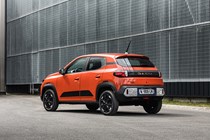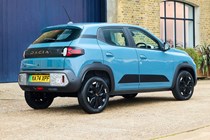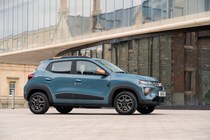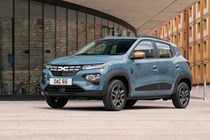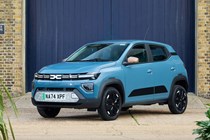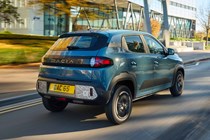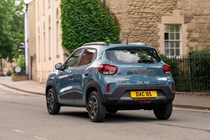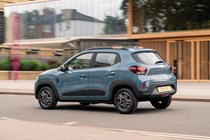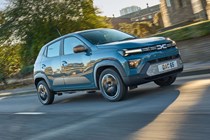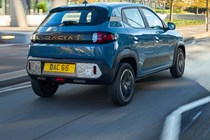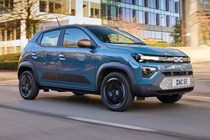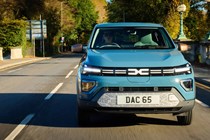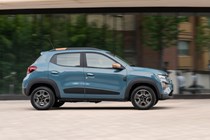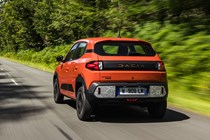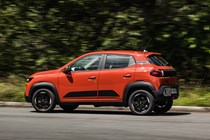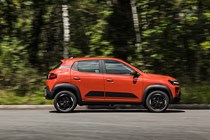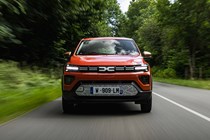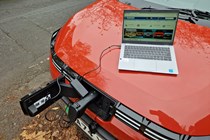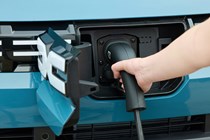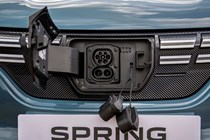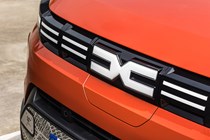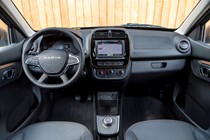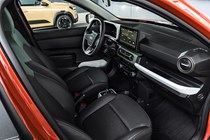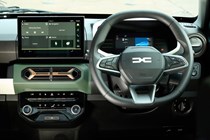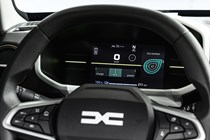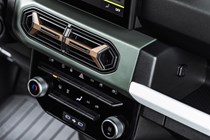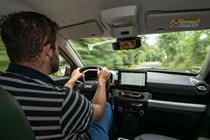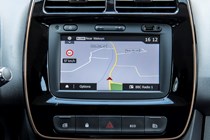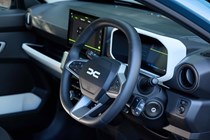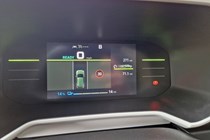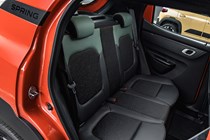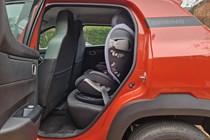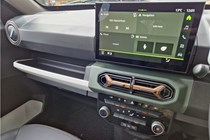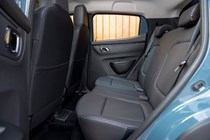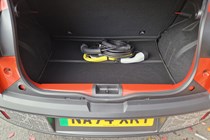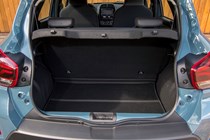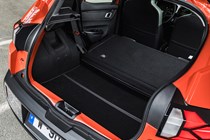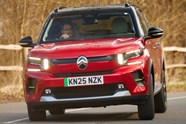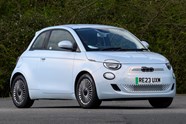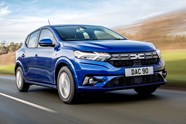Dacia Spring review
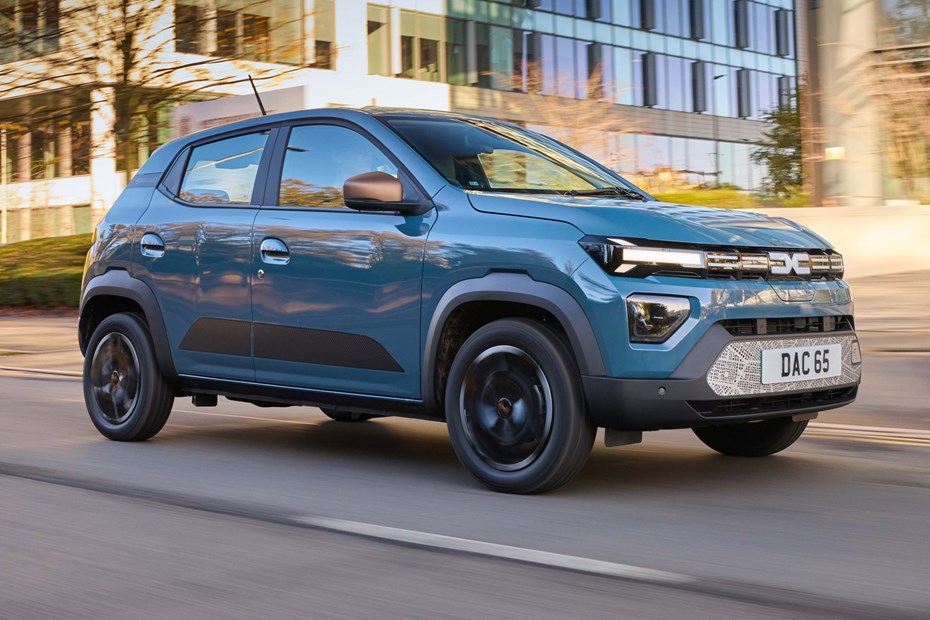
At a glance
| Price new | £14,995 - £16,995 |
|---|---|
| Used prices | £8,809 - £12,075 |
| Road tax cost | £195 |
| Insurance group | 24 - 25 |
Get an insurance quote with

|
|
| Fuel economy | 4.4 - 4.6 miles/kWh |
| Range | 140 miles |
| Miles per pound | 7.0 - 13.5 |
| Number of doors | 5 |
| View full specs for a specific version | |
Available fuel types
Fully electric
Pros & cons
- One of the cheapest new EVs you buy
- Interior is modern and easy to use
- Up to seven years of warranty
- One-star Euro NCAP safety rating
- Very flawed to drive
- Clearly built to a (low) price
Dacia Spring Hatchback rivals
Overview
Should you buy one?
We find that it is a hard car to recommend. Yes, it is cheap, and to sell a brand new electric car for as little as £14,995 there were always going to be compromises. Perhaps for some customers the ones Dacia has made will be acceptable.
To be clear, we have no issue with the small size of the battery pack and the associated 140-mile driving range. Nor are we particularly concerned about the limited performance. These aspects are perfectly acceptable for the price, as are the limited passenger space and general build quality – which is actually pretty good on the inside.
But the driving dynamics and the one-star Euro NCAP rating are another matter entirely. We’re struggling to think of any other new car will serve you so poorly in these areas, and the number of genuinely good nearly new ones you can buy for the price of the Spring means you really don’t have to compromise.
What’s new?
The Dacia Spring is being pitched as the most affordable new electric car you can buy in the UK. Priced from just £14,995, it’s certainly one of the cheapest EVs (electric vehicles) on sale here. it undercuts even budget-orientated newcomers such as the Leapmotor T03 and costs significantly less than the likes of the Citroen e-C3 and MG4 EV.
As such, the Spring aims to do for electric cars what the established Dacia range has done for petrol and diesel. Provide low-cost motoring that’s great value yet also appealing thanks to an attractive combination of practicality and no-nonsense design that still has some flair.
Fundamentally, the Spring achieves this aim. It gives you five doors, four seats, a good-looking interior, and enough performance and driving range to more than cope with pottering around town – a mission the compact dimensions and beefed-up bodywork certainly gel with.
Those weird stickers on the bumpers? They’re supposed to protect the car from low-speed scrapes, and can be easily replaced. Similarly, the exterior plastics are tinted right the way through, to better hide scratches.
However, it’s also clear that compromises have been made. That was inevitable, given the pricing, but it’s important to understand the impact of this so you can make a proper decision about whether this is the right car for you.
Firstly, that low entry price gets you only 45hp. The Spring is very lightweight – just 976kg in its most basic Expression spec – but that’s still not a lot of power. The more powerful 65hp version is hardly a rocket, either, and this costs from £15,995. The range-topping 65hp Extreme model we’ve been testing is £16,995, and weighs 984kg.
Secondly, the Spring has a one-star Euro NCAP crash-test rating. Now, this does date from 2021, when the Spring first launched in Europe, and its entry in the UK coincides with the introduction of a facelifted model. But we’re still not convinced a car with a 49% score for adult occupant safety, let alone 56% for child occupant safety (and just 39% for vulnerable road users), makes a good buy in 2025.
Thirdly, the way it drives contrasts badly with almost every other modern car. We’ll go into greater detail about this in the driving section of the review, but among the reasons to set alarm bells ringing are the Chinese Linglong tyres, which don’t seem to meet the standards of grip and traction we’re used to from European rubber.
The Spring itself is built in China, as it happens. But the clearly cost-conscious build quality has more to do with price-point than country of origin. So blame the tinny doors on that, not the location of manufacture. In much the same way that the small 26.8kWh battery pack and 140-mile official driving range are also consequences of the showroom figures.
Even with the eye-catching pricing we have further reason for pause. Check out the ownership cost page of this review to see how the Spring really compares to more expensive new and nearly new rivals. You might be surprised.
Having sampled pre-production models and attended the European launch, we’ve now driven the Dacia Spring in the UK on roads we’re intimately familiar with. This should clear up any confusion about the adjustment of our star rating. For more info, we also have a page that explains how we test cars at Parkers.
The following pages of this Dacia Spring review examine every element of this low-cost EV in detail, covering its practicality, interior, safety, driving experience and efficiency, before concluding with our full Dacia Spring verdict.



